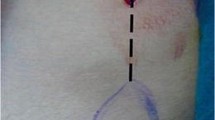Abstract
Introduction
Case report about a minimally invasive technique for removal of a femoral antegrade nail (FAN). Femoral nails are introduced by minimally invasive techniques, but are often removed with more invasive surgery.
Materials and methods
Four cases of young patients are described in whom the femoral nail was removed after consolidation by a minimally invasive extraction technique at the trochanteric site. By using a threaded wire for locating the proximal entrance of the femoral nail followed by reaming over the wire, the entrance of the nail in the trochanteric region is freed. Then the extraction bolt can be placed over the wire and the nail can be extracted through the same incision as it was inserted in, without enlarging the incision.
Discussion
This case report discusses a technique for minimally invasive femoral nail extraction, not the necessity of removing nails. Leaving out the endcap at the initial operation is the only preoperative condition, since the endcap blocks the entrance of the nail. This operation is done with fluoroscopic guidance. The difficult part is the reaming. The reamer must not be damaged when approaching the nail entrance. This minimally invasive femoral nail extraction technique is applicable for various types of femoral nails.
Conclusion
Minimally invasive extraction of femoral nails is possible and needs more attention. The level of evidence is a level IV case series.





Similar content being viewed by others
References
al Maleh AA, Nielsen KS (1998) How to remove a bent intramedullary nail. A technical note. Acta Orthop Scand 69:638–639
Cree AK, Ruff SJ (1995) Use of a tap extractor to remove a broken tap within a Grosse-Kempf intramedullary nail: case report. J. Trauma 38:802–803
Georgiadis GM, Heck BE, Ebraheim NA (1997) Technique for removal of intramedullary nails when there is failure of the proximal extraction device: a report of three cases. J Orthop Trauma 11:130–132
LaSalle WB, Horwitz T (1974) A method to cut and remove in situ bent intramedullary nail. Clin Orthop 0:30–31
Sivananthan KS, Raveendran K, Kumar T, and Sivananthan S (2000) A simple method for removal of a broken intramedullary nail. Injury 31:433–434
Author information
Authors and Affiliations
Corresponding author
Additional information
Concerning funding, there was no financial support for this report.
Rights and permissions
About this article
Cite this article
van Eerten, P.V., Reemst, P.H.M. & Repelaer van Driel, O.J. Minimally invasive femoral nail extraction. Arch Orthop Trauma Surg 125, 197–200 (2005). https://doi.org/10.1007/s00402-005-0799-1
Received:
Published:
Issue Date:
DOI: https://doi.org/10.1007/s00402-005-0799-1




